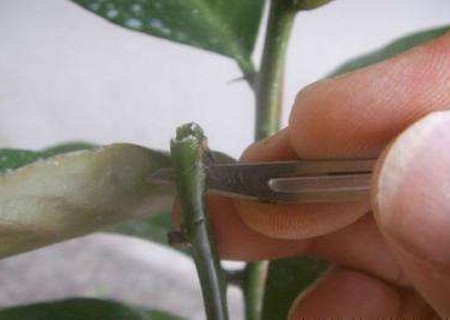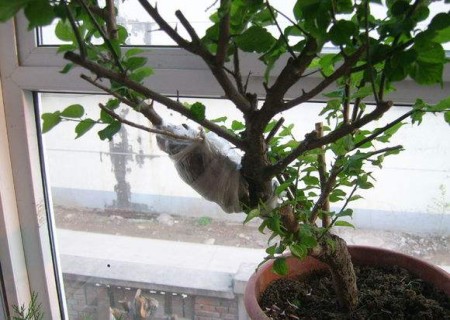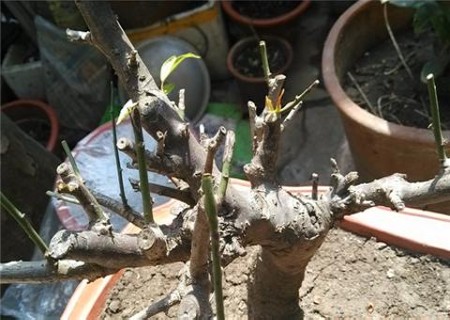Diagram of grafting method of Plum Blossom Bud grafting
Bud grafting is to cut a bud from the branch, with or without xylem, insert it into the incision on the rootstock, and bind it to make it close to heal. The bud grafting should be carried out in the slow growth period, so the cambium cells are still very active and the tissue of bud grafting has been enriched.
Potted plum blossoms are mainly propagated by grafting, commonly used for cutting and budding. Use hairy peaches or apricots for anvil. Apricot tree old dry skin red, grafted red plum, flower skin color coordination. The bud grafting is carried out from August to September, and the "T" shape connection method is generally used.
The specific steps in the budding process are as follows:
1. First cut a knife 1-1.5 cm above the ear bud, then cut it forward and downward from 1 cm below the bud, and gently peel off the wood inside the cortex of the bud (some with wood buds in recent years), including the population.

2. Cut the rootstock 5 cm from the soil, then cut down from the center of the cut, showing a "T" shape, then gently peel off the cortex and insert the prepared scion into the cortex of the "D" mouth.
3. The budding should be solid, and the upper end should be closely combined with the upper end of the "D" mouth of the rootstock, and finally tied up with plastic film strip or polyester tape. Check the survival situation a week later, if the petiole falls immediately and the bud is green and full, it means survival.
4. In the following spring, cut off the top of the rootstock 5-6 cm above the interface, and the scion will germinate quickly. after that, pay attention to cutting the rootstock buds, and when you need to change the pot or plant it on the pot, you can plant it deeply downwards to make the interface as low as possible, tie it up according to the growth, and lead it to form a beautiful shape.
The fragrance of plum blossom comes from the cold winter. From the poem, plum blossom is a particularly hardy plant, and the tenacity of plum blossom vitality can also be seen. But no matter how tenacious creatures are, if they are not handled properly, they will die, and no creature can fully adapt to any environment. Therefore, the grafting of plum blossom is also a very complicated technical work.
The following are the main technical points of bud grafting of plum blossoms:
1. Selection of budding rootstocks.
For the seedlings of peach and apricot in the same year, or the new branches extracted in the same year, the branches with a diameter of 0.3 to 0.4cm were selected.
2. Selection and treatment of budding.
The strong branches of the mother tree were picked out more than ten days before grafting, and the full buds were selected in the middle and upper part of the grafting.
3. Grafting process
In the Gregorian calendar, T-shaped buds are used from mid-June to early July, opening 5 to 15 centimeters above the ground (5 to 10 centimeters for new branches). Pay attention to 3-4 leaves below the opening. When cutting bud slices, we must pay attention to keep the petiole and try our best to ensure the integrity of bud slices. If the wrinkle is serious or the bud core is damaged, do not use it. It is recommended to take it again. May take the bud piece to contain in the mouth, might as well wet with a little saliva, pick open the rootstock cortex, insert the bud into the opening, wrap it tightly with plastic film, the tightness is not to injure the bark, do not enter the water.
3. Post-processing
The petiole of the bud will fall off automatically after 5 to 10 days of grafting, and it can be boldly unbound in about 10 days. Observe whether the grafted buds survive fresh green (blackened and necrotic ones can be grafted at the bottom). If there is no obvious necrosis, cut the anvil 1 cm above the interface in 3 to 4 days. Do not remove the leaves under the buds, and observe them every three or two days. Wipe off the sprouting buds of the rootstock in time, otherwise it is easy to suck the buds to death. More than ten days after cutting the anvil, the buds will germinate.
This method has a very high survival rate and is growing vigorously. The tallest ones I have received so far are already 35 centimeters long, so you might as well give it a try.
Time: 2019-06-09 Click:
- Prev

High pressure Propagation Technology of Plum Blossom
Potted plum blossoms are mainly propagated by grafting, commonly used for cutting and budding. Use hairy peaches or apricots for anvil. Apricot tree old dry skin red, grafted red plum, flower skin color coordination. However, the strip pressing method can be used when the breeding capacity of plum is not large. Striping is a traditional method of propagation of plum blossoms, and it is appropriate to select 1-3-year growing branches in early spring from February to March.
- Next

The method of cutting and raising seedlings of Plum Blossom grafting
Plum blossom is usually propagated by grafting, because the seedlings are often not easy to transmit the good characters of the female parent, and the grafting is divided into cutting and bud grafting. We have talked about plum blossom bud grafting technology before, this article will talk about the plum blossom cutting seedling method! Needless to say, scion is the same as usual.
Related
- Fuxing push coffee new agricultural production and marketing class: lack of small-scale processing plants
- Jujube rice field leisure farm deep ploughing Yilan for five years to create a space for organic food and play
- Nongyu Farm-A trial of organic papaya for brave women with advanced technology
- Four points for attention in the prevention and control of diseases and insect pests of edible fungi
- How to add nutrient solution to Edible Fungi
- Is there any good way to control edible fungus mites?
- Open Inoculation Technology of Edible Fungi
- Is there any clever way to use fertilizer for edible fungus in winter?
- What agents are used to kill the pathogens of edible fungi in the mushroom shed?
- Rapid drying of Edible Fungi

